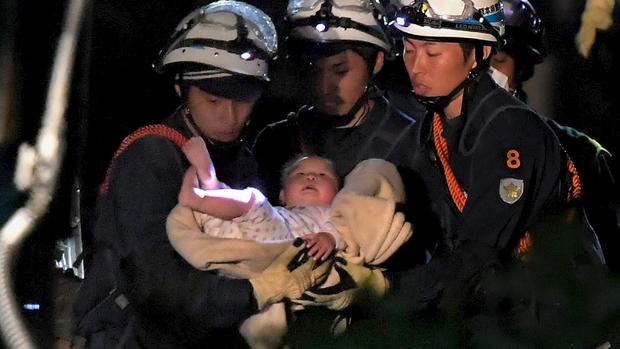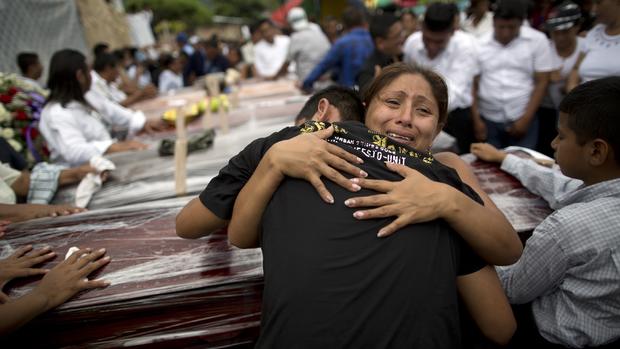Were the Japan and Ecuador earthquakes related?
They may have happened within days of one another, but the devastating earthquakes in Japan had nothing to do with the strong temblor that struck Ecuador over the weekend, experts say.
Both Japan and Ecuador are located along the so-called Pacific Ring of Fire, which spans the coasts lining the Pacific Ocean. The regions along the Ring of Fire are prone to earthquakes, but it's extremely rare for an earthquake on one side of the world to trigger earthquakes on the other, said Ross Stein, CEO and co-founder of Temblor.net, a free website and smartphone application that helps people understand locations' seismic risk.
For one thing, the earthquakes that hit Japan are a completely different type of quake than the one that struck Ecuador, Stein said. On April 14, a magnitude-6.2 earthquake hit southern Japan, and a day later, on April 15, a magnitude-7.0 earthquake struck the same region, according to the U.S. Geological Survey (USGS). [The 10 Biggest Earthquakes in History]
Both of these earthquakes were strike-slip earthquakes, Stein said, which occur when two parts of the Earth's crust slide against each other. The best way to imagine this is to place your hands together, with your fingers pointing away from your body, and slide your left hand forward and your right hand backward.
Both of these strike-slip earthquakes were shallow -- about 6 to 8 miles (10 to 12 kilometers) deep -- and both were destructive, killing more than 40 people in total, according to news sources. But the second quake was about 20 times stronger than the first, and released about 400,000 times more energy than the amount unleashed by the atomic bomb dropped on Nagasaki in 1945, Stein and Volkan Sevilgen, the other Temblor.net co-founder, wrote in a blog post.
These two earthquakes in Japan were likely related, Stein said. However, it's unclear whether the magnitude-6.2 earthquake was a foreshock of the magnitude-7.0 earthquake or the magnitude-7.0 earthquake was an aftershock of the magnitude-6.2 earthquake, Stein said.
"So far, the evidence suggests that both are true," the experts wrote in the blog post. Though it's rare for an aftershock to be larger than the main shock, it does happen, Stein told Live Science.
Regardless, the first earthquake made the faults near it more likely to rupture, which likely helped to trigger the second, larger earthquake, Stein said.
Ecuador earthquake
On Saturday (April 16), merely a day after the second Japanese earthquake, a massive magnitude-7.8 earthquake rocked Muisne, Ecuador, the USGS reported. [Image Gallery: This Millennium's Destructive Earthquakes]
Unlike the strike-slip earthquakes in Japan, this one was a so-called megathrust quake, which occurs when one tectonic plate jams under another. In this case, the Nazca Plate is moving under the South American continent at a rate of about 2.2 to 2.4 inches (55 to 61 millimeters) a year, Stein and Sevilgen wrote in another blog post.
More than 400 deaths have been reported from the Ecuador quake so far.
This isn't Muisne's first large earthquake. Another magnitude-7.8 earthquake hit almost the exact location in 1942, Stein said. In fact, given that the subduction rate is about 2.3 inches (60 mm) a year, and nearly 75 years have elapsed since the last large earthquake, it makes sense that this is a "repeat earthquake," Stein said.
But there's more to the story, he said. In 1906, Muisne experienced a magnitude-8.3 earthquake, so there may be other forces at work beyond a simple "repeat" event, he said.
"Considering that this site was part of the 10-times-larger event in 1906, it is particularly baffling," the experts wrote in the blog.
Even though the earthquake in Ecuador is unrelated to the two earthquakes in Japan, there is evidence that a gigantic earthquake can trigger others around the world. For instance, the magnitude-8.6 earthquake that struck the east Indian Ocean in 2012 is the largest strike-slip event on record, according to a 2012 study in the journal Nature, written by Stein and his colleagues.
After that massive earthquake, there was a nearly fivefold increase in earthquakes with a magnitude of 5.5 or greater for six days after the event, the researchers found.
"Those aftershocks tended to be strike-slip as well," Stein said. "It was mama calling to her kids."
Follow Laura Geggel on Twitter @LauraGeggel. Follow Live Science @livescience, Facebook & Google+. Original article on Live Science.

